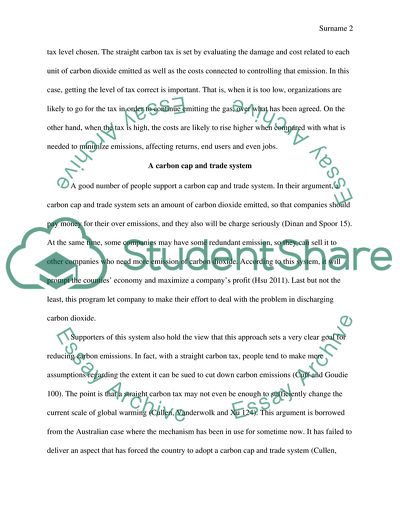Cite this document
(Which System Will Work Better, a Carbon Cap, and Trade System or a Coursework Example | Topics and Well Written Essays - 1250 words, n.d.)
Which System Will Work Better, a Carbon Cap, and Trade System or a Coursework Example | Topics and Well Written Essays - 1250 words. https://studentshare.org/environmental-studies/1809855-for-reducing-emissions-of-carbon-dioxide-which-system-will-work-better-a-carbon-cap-and-trade-system-or-a-straight-carbon-tax
Which System Will Work Better, a Carbon Cap, and Trade System or a Coursework Example | Topics and Well Written Essays - 1250 words. https://studentshare.org/environmental-studies/1809855-for-reducing-emissions-of-carbon-dioxide-which-system-will-work-better-a-carbon-cap-and-trade-system-or-a-straight-carbon-tax
(Which System Will Work Better, a Carbon Cap, and Trade System or a Coursework Example | Topics and Well Written Essays - 1250 Words)
Which System Will Work Better, a Carbon Cap, and Trade System or a Coursework Example | Topics and Well Written Essays - 1250 Words. https://studentshare.org/environmental-studies/1809855-for-reducing-emissions-of-carbon-dioxide-which-system-will-work-better-a-carbon-cap-and-trade-system-or-a-straight-carbon-tax.
Which System Will Work Better, a Carbon Cap, and Trade System or a Coursework Example | Topics and Well Written Essays - 1250 Words. https://studentshare.org/environmental-studies/1809855-for-reducing-emissions-of-carbon-dioxide-which-system-will-work-better-a-carbon-cap-and-trade-system-or-a-straight-carbon-tax.
“Which System Will Work Better, a Carbon Cap, and Trade System or a Coursework Example | Topics and Well Written Essays - 1250 Words”. https://studentshare.org/environmental-studies/1809855-for-reducing-emissions-of-carbon-dioxide-which-system-will-work-better-a-carbon-cap-and-trade-system-or-a-straight-carbon-tax.


